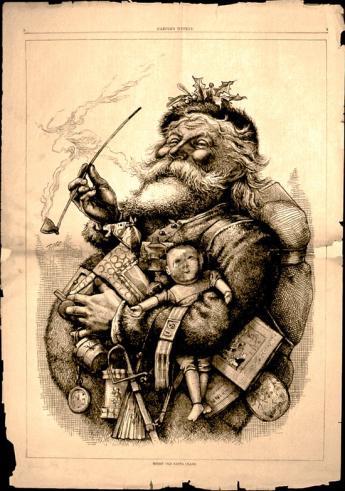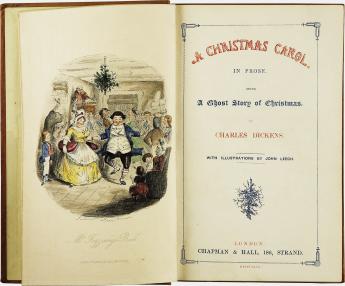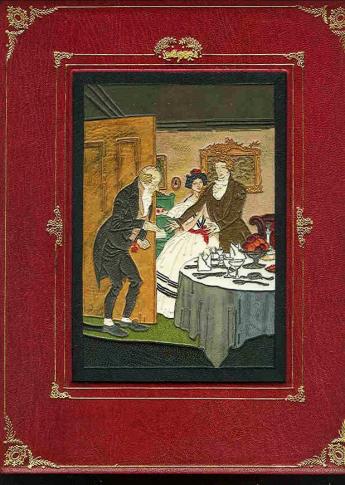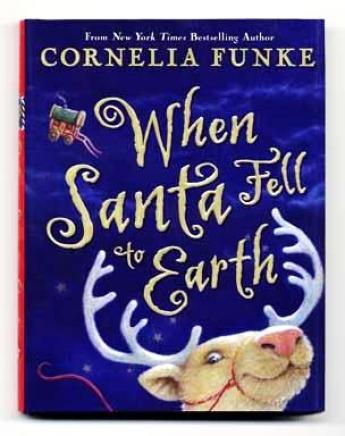Christmas and The Private Library, Part 2
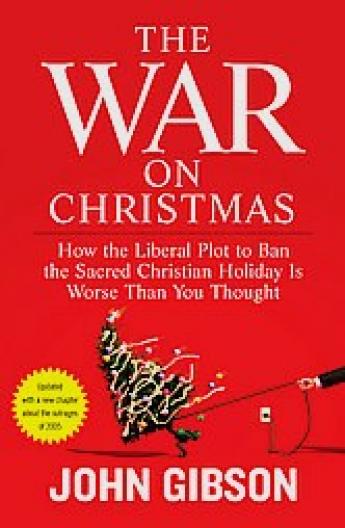
By L. D. Mitchell
Because Christmas celebrations in most parts of the Western world are a mix of often competing strands of paganism, folklore, mythology and religion, the holiday has been both heavily promoted and heavily criticized over the centuries.
During the English Interregnum, for example, the English Parliament banned the celebration of Christmas altogether. From 1644-1660,
[a]ll shops and markets were to stay open throughout the 25th December and anyone caught holding or attending a special Christmas church service would suffer a penalty. In the city of London things were even stricter as soldiers were ordered to patrol the streets, seizing any food they discovered was being prepared for a Christmas celebration.
This ban was effected in part because the Puritans felt that Christmas celebrations were an unwanted remnant of the Roman Catholic Church and, therefore, a tool of encouragement for the diss[ident] community that remained in both England and Wales. They argued that nowhere in the Bible had God called upon his people to celebrate the nativity in this manner. (Several other holidays also were banned for containing Popish elements, including Easter.)
The Puritans also were unhappy with the fact that celebrations of Christmas often led to drunkenness, promiscuity, gambling and other forms of excess. So the celebration of Christmas in England went underground for a while, even as those Puritans who set sail for the Americas took the urge to ban Christmas with them (a ban that would be effected in Boston from 1659-1681).
In some parts of the world the war over Christmas continues to this day, as several recent books make clear. (Stephen Nissenbaum, The Battle for Christmas; John Gibson, The War on Christmas).
In any event, Christmas remained for most people largely a community and/or church celebration. Due to repeated and prolonged sectarian tensions, celebration of the holiday had, over the centuries, been seriously diminished in many locales, and might well have died out altogether had it not been for the publication of several works of fiction in the early decades of the 19th century. These titles not only revived the holiday itself, but also, for many celebrants, shifted the focus of the celebration away from church and community to family.
Perhaps most significant among such works of fiction were Washington Irving's The Sketch Book of Geoffrey Crayon (1819-1820), which supposedly drew upon the tract Vindication of Christmas (1652) for many elements of its stories about Christmas; Clement Clarke Moore's A Visit from St. Nicholas (first published anonymously in New York's Troy Sentinel newspaper on 23 December 1823); and, most influential of all, Charles Dickens' A Christmas Carol (1843).
Initially published in seven serial installments from June 1819-September 1820, Irving's Sketch Book probably is better known today for Rip Van Winkle (published in the first installment) and The Legend of Sleepy Hollow (published in the sixth installment) than for the other twenty-seven stories and essays that comprised its first American publication. It was, however, the five stories published in the fifth installment of January 1820 - which revolved around an idealized Christmas celebration at an English country manor - that contributed to a revitalization of Christmas celebrations in the New World, and that had a self-professed influence on Dickens' own contribution to that revival.
Moore, whose authorship of A Visit from St. Nicholas has been debated for decades (usually resolving in Moore's favor), is responsible for, among other things, giving each of Santa's eight reindeer individual names:
More rapid than eagles his coursers they came,
And he whistled, and shouted, and called them by name;
"Now, Dasher! now, Dancer! now, Prancer and Vixen!
On, Comet! on Cupid! on, Dunder and Blixem!
To the top of the porch! to the top of the wall!
Now dash away! dash away! dash away all!"
(The names of the last two reindeer would be changed in later printings to Donder and Blitzen.)
The illustrations that accompanied the many re-printings of this poem also would significantly impact the public's perception of the mythical figure of Santa Claus (although it would be caricaturist Thomas Nast's illustrations of Saint Nick, depicted below, that would have the greatest and most long-lasting impact).
In the December 2009 issue of Fine Books & Collections, author Jonathan Shipley argues that one reason Dicken's A Christmas Carol has had such an oversized influence on modern Christmas celebrations is that the author himself frequently read from this work, to great effect, during several public lecture tours in Great Britain and America.
Penned during a feverish six weeks in the fall of 1843, all 6000 copies of the initial press run of A Christmas Carol sold out on its first day of publication, 19 December 1843. Because the great expense of its hand-colored plates cut considerably into Dickens' profits (financial pressures had been the reason Dickens had written it in the first place), this was Dickens' first and only book to be published with such plates.
Dicken's "little carol" has never been out-of-print, and it has inspired some of the world's best illustrators, printers and binders during the course of its many reprints.
The British poet and editor Thomas Hood had declared shortly after publication of A Christmas Carol that [i]f Christmas, with its ancient and hospitable customs, its social and charitable observances, were ever in danger of decay, this is the book that would give them a new lease.
How right he was. The book remains the essential title for any private library focused on Christmas.
In the 166 years since A Christmas Carol's original publication, thousands of Christmas-themed works of fiction have been published worldwide in a huge variety of languages. Such books are readily found, and eagerly sought, at yard sales, garage sales, friends-of-the-library book sales, publishers' clearance sales, and in all manner of bookshops around the world.
The publication of so many Christmas-themed titles often makes it difficult to critically assess the influence of such literature, although a few attempts have nonetheless been made, for example by Michaela Thurner-Uhle (“The Representation and Function of Christmas in English Literarue of the 19th and 20th Centuries).
Tomorrow, we will examine some of the books reflective of the increasing industrialization of Christmas since the mid 19th century.
To be continued …
Are you collecting Christmas Carols?
>>> Browse the ILAB Metasearch
***
Published on L. D. Mitchell's famous blog The Private Library. Part 3, presented here by permission of the author. Thank you very much. Pictures: The Private Library.
